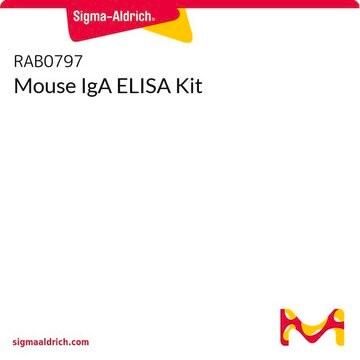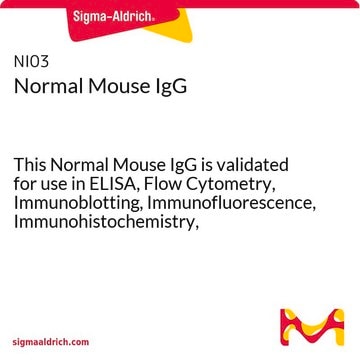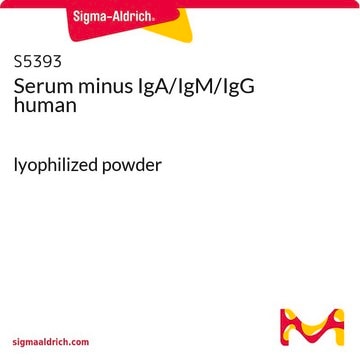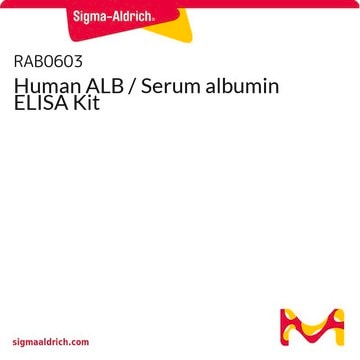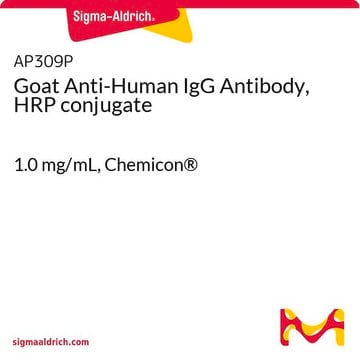RAB0001
Human IgG ELISA Kit
for serum, plasma
Sinónimos:
IgG, Immunoglobulin-G
Iniciar sesiónpara Ver la Fijación de precios por contrato y de la organización
About This Item
UNSPSC Code:
41116158
NACRES:
NA.32
Productos recomendados
species reactivity
human
technique(s)
ELISA: suitable
capture ELISA: suitable
shipped in
wet ice
storage temp.
−20°C
General description
Immunoglobulin G (IgG) belongs to immunoglobulin family, and consists of gamma (γ) heavy chain in the constant (C) region. IgG is a widely expressed serum antibody. Monomeric structure of IgG constitutes two identical heavy chains and two identical light chains with molecular weights of 50kDa and 25kDa respectively. The primary structure of this antibody also contains disulfide bonds linking the two heavy chains, linking the heavy and light chains, and are present inside the chains. IgG is further subdivided into four classes namely, IgG1, IgG2, IgG3, and IgG4 with different heavy chains, named γ1, γ2, γ3, andγ4, respectively. IgG is produced and released from CD5+ B cells, the predominant lymphocytes in the neonatal cell repertoire. Maternal IgG is the only antibody transported across the placenta to the fetus. Maternal IgG passively immunizes the infants.
This ELISA (enzyme-linked immunosorbent assay) kit is an in vitro enzyme-linked immunosorbent assay for the quantitative measurement of a target protein in biological samples such as serum, plasma, cell culture supernatants, urine and/or cell and tissue lysates. This assay employs a specific capture antibody coated on a 96 well plate.
Immunogen
Recombinant Human IGG
Application
Human IgG ELISA Kit has been used to determine the total IgG antibody levels in serum samples of new borns. It has also been used to validate the micro-bead injection spectroscopy (μ-BIS)- lab-on-valve (LOV) method for the determination of serum immunoglobulin G (IgG).
Other Notes
A sample Certificate of Analysis is available for this product.
Please type the word sample in the text box provided for lot number.
Please type the word sample in the text box provided for lot number.
signalword
Warning
hcodes
pcodes
Hazard Classifications
Met. Corr. 1
Storage Class
8B - Non-combustible corrosive hazardous materials
Certificados de análisis (COA)
Busque Certificados de análisis (COA) introduciendo el número de lote del producto. Los números de lote se encuentran en la etiqueta del producto después de las palabras «Lot» o «Batch»
¿Ya tiene este producto?
Encuentre la documentación para los productos que ha comprado recientemente en la Biblioteca de documentos.
Los clientes también vieron
Norio Hanata et al.
Frontiers in immunology, 11, 1095-1095 (2020-07-14)
Peptidylarginine deiminase 4 (PAD4), encoded by PADI4, plays critical roles in the immune system; however, its contribution to the pathogenesis of lupus nephritis remains controversial. The pathological roles of PAD4 were investigated in lupus model mice. An imiquimod (IMQ)-induced lupus
Franck P Dupuy et al.
mBio, 10(6) (2019-12-19)
Measuring Envelope (Env)-specific antibody (Ab)-dependent cellular cytotoxicity (ADCC)-competent Abs in HIV+ plasma is challenging because Env displays distinctive epitopes when present in a native closed trimeric conformation on infected cells or in a CD4-bound conformation on uninfected bystander cells. We
Narmeen Mallah et al.
Frontiers in pharmacology, 11, 860-860 (2020-07-14)
Despite the wide benefits of aspirin and its cost-effectiveness, aspirin prescriptions have been reduced due to idiosyncratic responses in susceptible individuals. Low-dose aspirin and single-nucleotide polymorphisms (SNPs) are independently associated with increased risk of gastrointestinal hemorrhage; however, to-date, no studies
Santa Rasa-Dzelzkaleja et al.
Brain sciences, 10(5) (2020-05-15)
Human herpesviruses (HHV)-6A, HHV-6B and HHV-7 are considered to be involved in the pathogenesis of epilepsy, a common neurological disorder. The objective of this study was to determine the association of roseoloviruses infection with epilepsy. 53 epilepsy patients and 104
Cheryl Yi-Pin Lee et al.
Clinical & translational immunology, 9(4), e1126-e1126 (2020-04-30)
Zika virus (ZIKV) is a mosquito-borne flavivirus that re-emerged in 2015. The association between ZIKV and neurological complications initiated the development of relevant animal models to understand the mechanisms underlying ZIKV-induced pathologies. Transient inhibition of the type I interferon (IFN)
Nuestro equipo de científicos tiene experiencia en todas las áreas de investigación: Ciencias de la vida, Ciencia de los materiales, Síntesis química, Cromatografía, Analítica y muchas otras.
Póngase en contacto con el Servicio técnico